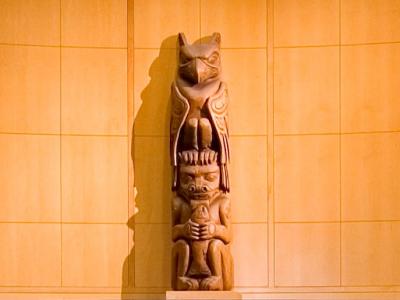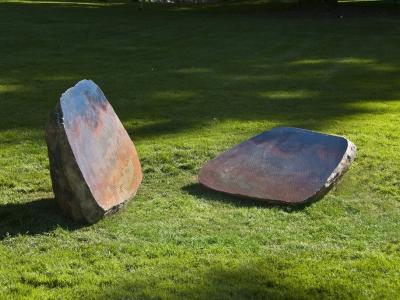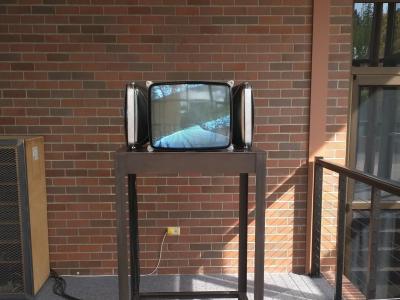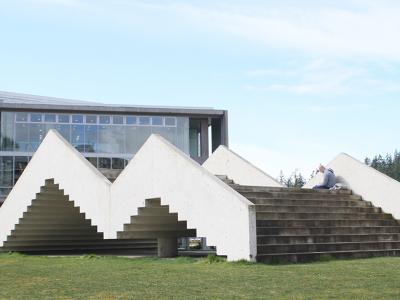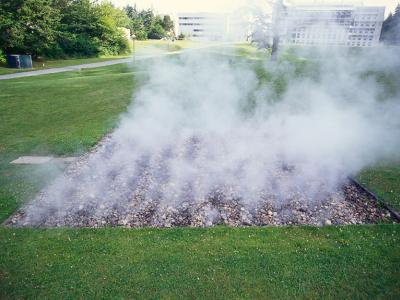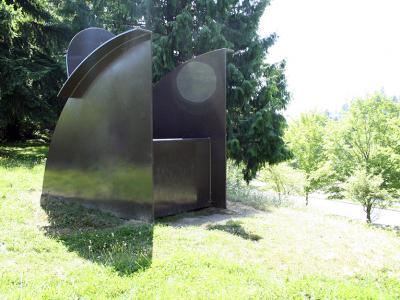Dale James, Thunderbird and Bear and Steelhead Totem Pole, 1996
Dale James, 1996.
Cedar. 7' h x 9"
Photo credit: Rod del Pozo
Diversity Funds, Western Foundation, for the University at request of Provost Larry DeLorme and Vice President for Diversity, Larry Estrada.
Description
This "Totem Pole" depicts three figures. The first is the "Thunderbird." The second primary figure is the "Bear" holding the "Steelhead." Master Carver James had chosen these two primary figures for their representational value of the Lummi view of the world around them, and that of other Coast Salish Tribes. While each figure represented by "totems" is significant to the carver, and the tribal peoples, not all can be presented on one totem. Thus, the carvers are at liberty to carve only those figures they are moved to express or those specifically commissioned by others to depict.
A large percentage of the present day Lummi can trace mutual ancestry to the Duwamish Tribe. This is Chief Seattle's people. Members of the Duwamish Tribe married into the Lummi Nation, before contact with Captain Vancouver in 1792. And, after the creation of the reservation system, the Duwamish moved to the several reservations created in the Pt. Elliot Treaty of 1855 (otherwise known as the Treaty with the Duwamish, Suquamish, and Allied Tribes).
Chief Seattle has a power that was significant in the way of the traditional spirit societies of the people. This was the power of the "Thunderbird." The Thunderbird represented a close connection with the concept of "Sky power" or "Sky God" for more than one tribe. The Thunder and Lightning are strong spiritual connections for all peoples. Those gifted with this power have always been significant in the history of our people. This power was a manifestation that the Great Spirit empowered all things with original gifts of creation.
Full text
The words of Chief Seattle, from the treaty negotiations, have been translated into almost every language of the world. It is esteemed as a statement to the "Indians" love and connection with the earth and sky. Thus, here, we see that Chief Seattle's Thunderbird power truly empowered his voice over the centuries and the world population.
The "Treaty of Point Elliot" preserved the right of Chief Seattle's people to fish for the salmon in their usual and accustomed fishing grounds and stations. This right is as old as there were Indian people in the area; in fact, it was older, since the people were here before the salmon arrived into the rivers. This totem depicts a part of that story — the story of conservation (Salmon Woman and Bear & the Steelhead)
This is the same with the story of "Bear and the Steelhead." Bear is a historical figure to us but a mythical figure to others. His brother was Raven. Raven was the leader that found "Salmon Woman" and brought her to the People. Salmon Woman was the mother of all of the salmon children. She gave her children to the human being (the people) to assure they would not starve to death. This was a great sacrifice on her part and that of her children. The only gift Raven could give back was to marry her and have her people accept her and this great gift with great humbleness and respect. The starving people no longer knew starvation or famine.
However, eventually the people got tired of having Chinook Salmon, Coho Salmon, Sockeye Salmon, Humpy Salmon, Chum Salmon, and Steelhead Salmon year round. They had boiled, broiled, steamed, barbequed, wind dried, sun dried, smoke dried, and raw salmon year round. Eventually, they abused the salmon children. So, Salmon Woman took all of here Salmon Children away.
Raven and his people nearly starved to death. They learned their lesson and promised Salmon Woman to never abuse her children again; if and only if she would bring them back to the river, to the people. She consented with conditions.
The salmon children will never live in the river year round ever again. They would leave for a term of years and then come back, although some will return each year in their time. And, they will never make their beds at the mouth of the river, near the villages of mankind; but, they would make their beds (spawning beds) upriver. The people accepted the conditions.
However, Raven's brother was Bear. Bear's wife was pregnant. While pregnant, Bear's wife could not, nor could Bear, be near any hunting, fishing, trapping, or gathering tools or implements. This was because of the great powers that women have during their creative powers of pregnancy — they are one with the creative powers. This was a mystery women shared with the cosmos and had to be respected. The taboos on Bear and his wife was to protect all those around her, and not meant to be a matter of disrespect toward her or Bear.
Raven would do all the hunting and fishing for Bear's family. While Raven and the other men were gone, Bear became restless. Eventually, he could no longer stay home. So, he went up river to "just catch a few salmon." But, when he touched the first Chinook salmon, all the other chinooks died in the spawning bed. When he touched the first Sockeye Salmon, all the sockeye died in the spawning beds. When he touched the first Humpy Salmon, all the other humpies died in the spawning beds. When he touched the first Coho Salmon, all the other coho died in the spawning beds. When he touched the first Chum Salmon, all the other chum died in the spawning beds.
Bear was under the influence of the "creative powers of his wife's pregnancy." He violated the taboos and the Salmon Children paid the price. All the people saw the dead chinook floating by the village, then the sockeye, then the humpy, then the coho, then the chum. The people were afraid and sent Raven up to find the problem.
Raven found his Brother Bear in the spawning beds, touching the Salmon Children. Raven stopped Brother Bear just before he touched the salmon called Steelhead. As a consequence, steelhead did not die in the spawning beds like his brothers and sisters. This is why steelhead sleeps in the spawning beds and returns to the oceans each year, without dying. But, because of Bear's actions, all the other salmon return each year to the spawning beds and then die after spawning.
Raven punished his Brother Bear. Now, Bear is down on all fours permanently. Since he kneeled down and got into the spawning beds, his Brother Raven left him like that. And, he is always fishing in the upper river area, where he was found violating the laws of Salmon Woman and the taboos of Raven's people.
Historical Note
The Lummi Indian Nation is indigenous to the San Juan Islands and the mainland from Skagit County, from the shores to the tips of the Cascade Mountain Range, going north into Canada, including the lands of Point Roberts. Our people are traditional, culturally, ceremonially, and spiritually tied to the land and Whulge (called Puget Sound today).
Our form of spirituality tied us to the cycles of the earth, the moon, the animals, the plants, and all other parts of creation. We were typical in our philosophy and spiritual practices of tribes otherwise known as "Coast Salish" of Washington.
Two important parts of our life/spirit cycle was recognition of the valued gifts of older brother and sister spirits to creation. We call these "Cedar" and "Salmon" today. Their gifts to the Indian peoples were phenomenal and made the Coast Salish the richest nations in the emerging United States. However, today, the ancient cedar forest and the endless runs of salmon are near extinction since first contact with the non-Indians in 1792.
As a Master Carver, Dale A. James kept this in mind and heart. Each piece of cedar, to him, is special. It represents a part of the end of an era. The final vestiges of a people’s spiritual connectedness with the earth and sky are drawing to a close in this century. The salmon are being listed for extinction and the ancient forest is nearly completely clear-cut.
The stories and spirituality depicted by Master Carver Dale James, in ancient, old growth cedar, is most likely going to be some of the last to be carved in our generation. By the time the next generation takes over the last of the old growth will be few and number and preserved by crisis and necessary for the biodiversity of the region, or completely depleted for the next several centuries.
We can only pray you can understand the significance of the "totem" in a world that has little or no appreciation for the rights of the American Indians, in this case the Coast Salish, as a culturally & spiritually unique people in the United States. We pray that you see deeper into the symbolism of the totem and find your own roots in the process.
Text © Jewell Praying Wolf James (November 15,1995)



